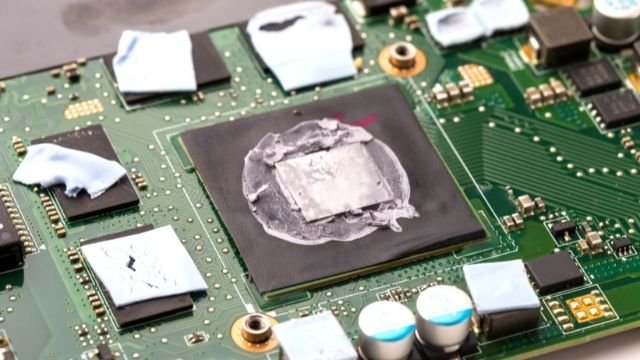Can Bad or Low-Quality Thermal Paste Cause Overheating? (Solution to Fix It!)
If you know something about computers, you’re aware they don’t do too well with heat — let alone overheat.
Whenever a component of your computer overheats, it slows itself down to cope with the generated heat. At the same time, it may get permanently damaged — which you want to avoid at all costs! That’s where active cooling comes into play. With a system of fans, a heatsink, and a thermal paste, your CPU and GPU get to stay under a safe temperature limit.
If your computer has been overheating lately, you may be wondering what’s its cause. Well, this post has got everything you need to know!
Let’s dive right into it.
Reason for CPU overheating
When your CPU runs, it produces heat as a byproduct. This heat has to be removed from the computer because it can cause throttling and long-term damage.
It’s transferred from the CPU to the heatsink through the thermal paste, and from there, it’s removed through a system of fans. If you’ve been experiencing overheating lately, we recommend checking your computer fans. If one or more of them aren’t working as expected, you might want to get them sorted out ASAP.
If, however, the fans are working fine, the culprit could be your thermal paste.
You see, the thermal paste is the heat conductor between the heatsink and the CPU. If it stops working as it should, the heat won’t be transferred between the two components as you’d expect. As a result, you’d face overheating on your computer.
Can dried thermal paste or degraded thermal paste cause overheating?
Yes. A dried-out thermal paste can cause overheating.
A traditional thermal paste is made out of an organic solvent, as well as a heat conductor. The solvent serves the purpose of filling in all the air gaps between the heatsink and the CPU, while the conductor transfers the heat between the two.
As a thermal paste gets older, the heat generated by the CPU dries it out. With time, the paste gets degraded and stops conducting the heat as effectively as it should.
At that point, you may start to notice extensive overheating in your computer.
Can low-quality thermal paste cause overheating?
Absolutely.
Depending on the quality of a thermal paste, its longevity could vary a lot. For example, a top-quality thermal paste can last you a couple of years, while the worst one may only work for a few months. Hence, you may start to notice overheating as soon as your specific thermal paste starts degrading.
That’s why it’s recommended to invest in a good-quality thermal paste, like Kooling Monster KOLD-01. Furthermore, the way you apply the thermal paste also plays a massive role in its performance.
You see, low-quality thermal pastes aren’t designed in a way that makes them easy to apply. So, it’s hard to get a flat and smooth layer of it on the CPU.
On the other hand, good-quality thermal pastes are designed to be easily applicable. For example, KOLD-01 has a unique rheological design, which helps you spread it easily by applying pressure. When you remove the pressure, it instantly starts acting like a solid and sticks in place.
A flat and smooth layer of thermal paste fills in all the air gaps effectively, which increases the thermal performance of your computer.
Can too much thermal paste cause overheating?
Again, yes!
Thermal paste has to be applied in a carefully calculated amount. Apply too little of it and the air gaps won’t be filled up. Put too much of it, and it spills to the sides. Plus, a thick layer of thermal paste essentially increases the physical distance between the CPU and heatsink, which, again, can cause overheating.
Unfortunately, putting in too much thermal paste is a common mistake that many novices do. They believe “more thermal paste means better thermal performance” — which is not correct! Click here to read our full insight on this subject.
How to avoid or fix CPU overheating
It all boils down to three simple rules:
Use the best quality thermal paste you can find out there.
Replace it whenever needed (which, in the case of a good-quality thermal paste, would be more than a few years.)
Kooling Monster KOLD-01 is a thermal paste that’s just right for you; it’s long-lasting, it’s easy to apply, and keeps your CPU as cool as it could get!
While traditional thermal pastes are made out of an organic solvent that dries out quickly, KOLD-01 is not. It’s made of a special combination of silicone and metal oxides, which lasts as long as it could get. In short, KOLD-01 not only helps your computer stay cool on a daily basis but also extends its overall lifespan over the long term.
There are many methods of applying the thermal paste on a CPU. But if you’re afraid of putting too much thermal paste on the CPU, you should opt-in for the buttered toast method.
Why, you ask? Well, because you don’t have to rely on the applied heatsink pressure to spread it. In this method, you essentially spread the paste on the CPU’s surface yourself, which makes sure you don’t leave any blank spots behind. Plus, this method is a life-saver if you’re afraid to apply too much thermal paste.
If you’d like to learn more about the various application methods of thermal paste, click here to read our full insight.
The bottom line
Thermal paste plays an important role in keeping your computer cool and performing well. And yes, a low-quality or degraded thermal paste can cause your computer to overheat!
If you’d like to never face such problems again, be sure to check out KOLD-01.





